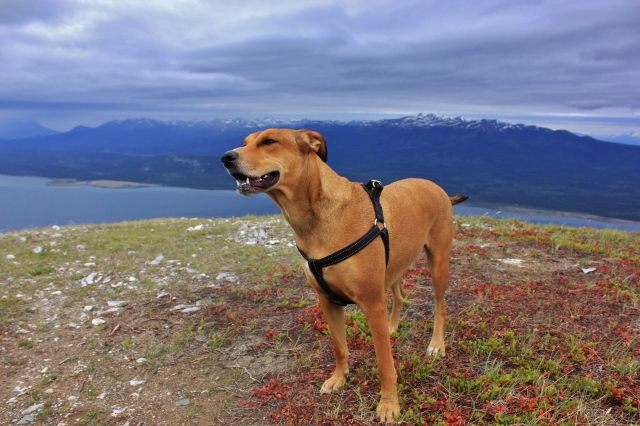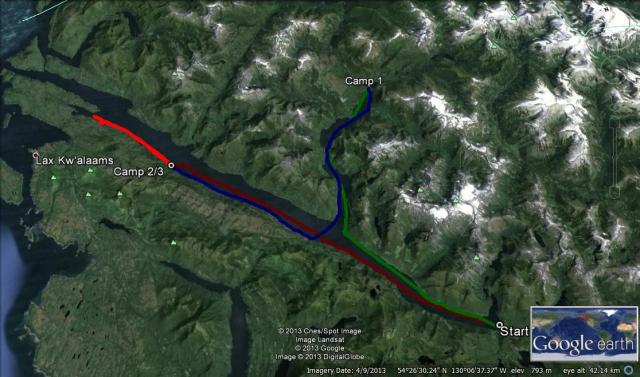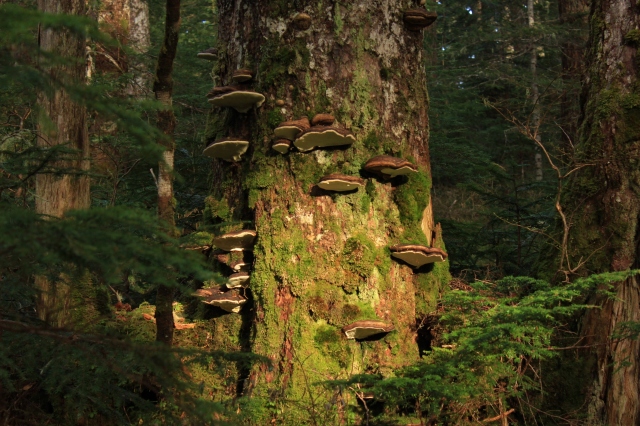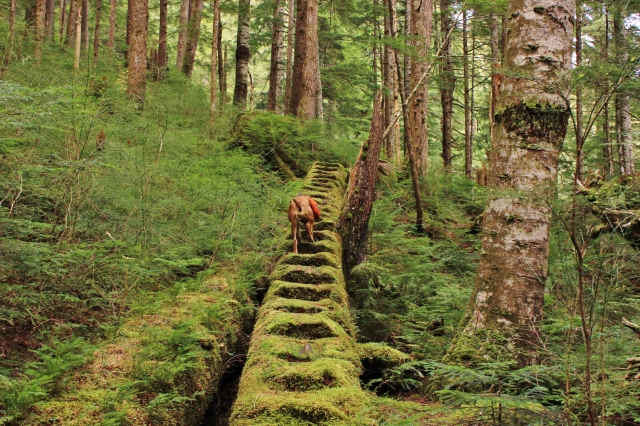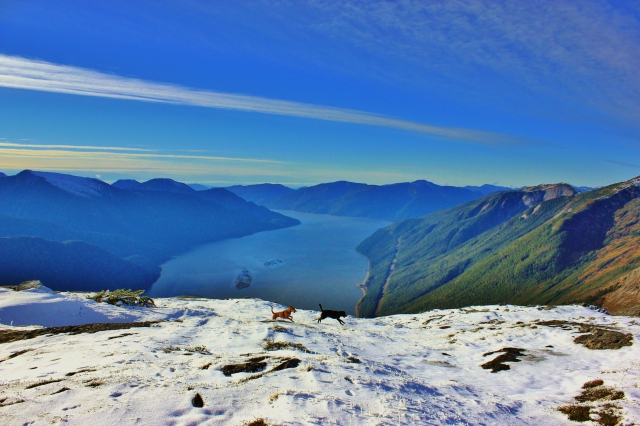The Pre-trip – Before any great adventure comes a great amount of planning. For some this is horrible, but I personally love it. I probably put almost as much time into the planning phase as the trip itself. The main points of planning are: what to eat, where to go, what gear to bring, and your safety net back in civilization. Food planning although time consuming, is relatively easy. Bring things that don’t spoil, that are easy to cook, or that don’t need to be cooked at all. We dehydrated all of our own veggies and most of the dried fruit that we brought along. Pasta, rice, nuts, oatmeal and beans were other staples that rounded out our meals. I have learned in the past that having a really good meal can turn around an absolutely horrible, windy, rainy day.
Deciding exactly where to go is likely the most difficult thing to do. There are so many places to see and only a limited amount of time. I try to find nice beaches to comb and camp on with a good balance of paddling and of course a nearby fresh water supply. Even in the worst conditions that I feel comfortable paddling in you can still easily make a good 20km. Tides of course must be taken into consideration and tides charts should be brought along and checked regularly.
Gear for kayaking has to be useful, light, and compact. Layers are important and you can never have too many dry-bags or matches. I find that keeping in touch with people in civilization is more for their peace of mind than mine. We used a spot messenger for semi-daily check-in and a VHF radio for weather and emergency communication. Once you have everything planned down to the last detail you can throw it all out the window as the weather is going to determine literally everything you do! We ended up with about 300-350lbs of “stuff” plus two people when we started out. Coming back, we weighed about the same when you take into consideration all the treasures we collected.

Day 1, July 2, 2013 – We left Kitimat’s MK Marina in “The Big O”, a 32 ft orange former navy zodiac. We had a full load headed out with myself, Jay, Marc and his 3 girls Sophia, Hazel and Iris, two 17ft kayaks, 8 days and 7 nights worth of gear and food for the two kayaks, a 9 ft inflatable zodiac plus two days of supplies for Marc and the girls. Our straight run from MK to Ethelda Bay (about 2.5-3 hrs), closely followed the proposed route the oil tankers would be taking.
Unfortunately, the dock that once existed at Ethelda Bay is no longer. We were unable to tell if it broke free from the pilings during a storm or if it was dismantled. When I was first at Ethelda bay in 2010, part of the dock was already falling into the ocean. Due to the lack of dock we tossed the kayaks overboard and hauled things to shore. We tied the big zodiac to what proved to be two anchored logs and then used the little inflatable boat to come to shore. Once everything was organized we quickly hiked over the island to catch low tide at the white-sand beach on the west side. This beach once produced a very large green glass float so hopes were high but no luck was had this time. We did, however, find several large non-glass Japanese floats, two floats from China, a large piece of bamboo and endless amounts of foreign garbage and bottles. After returning from our hike we set up two tents on the remaining boardwalk and had an early night. Dinner consisted of veggie burger and rice wraps. Tomorrow morning the real adventure begins.
Note: Ethelda Bay-Tennant Island Conservancy was designated as a conservancy on May 31, 2007 following recommendations from the North Coast Land and Resource Management Plan. Ethelda Bay was the site of a former manned radio beacon station (operated by the DOT, Ottawa) where a maintenance crew was once housed. A private couple purchased the houses, dock, generator station, and helicopter pad from the federal government in 1996 to develop a tourist and fishing lodge.
http://www.gent-family.com/radiohistory/chapter3a.html
http://gentfamily.com/EtheldaBay/etheldabay.html

Day 2, July 3, 2013 – Hitting the water at about 8am everything was dead calm. Little did we know this would be the calmest we would see the water. We paddled slightly east, and then north, before creeping west through a quick flowing channel out to open ocean. The tide was already on its way up when we popped out the other end of the uncharted channel, waves were crashing on rocks and reefs all around us. We stayed a safe distance from shore and snaked our way towards our first destination where we set up camp. The distance was about 10km and it took us about 2 hours. We chose a site that was tucked out of the wind that didn’t have too large a sand bar to deal with at low tide. After setting up camp we decided to investigate the beach around Oswald Bay which was only a short paddle away. We beachcombed the entire beach and circumnavigated the island that is connected at low tide. I found many treasures including several plastic floats that I towed back to camp and no end of seashells, but no glass floats. For those who don’t know I am obsessed with finding glass floats and more or less planned this trip so we could find some and bring them home. While on our 4-5 hour beachcomb we took a closer look at the uncharted pass between Dewdney and Barnard Island. We will have to make our way through this pass on Day 4 and hope that we have a high enough tide to do so. The Tide had gone out while we beachcombed and the white sand beach around Oswald has a very gradual slope leaving us a decent portage to get back to the water. Upon arrival back at camp we found fresh wolf tracks. In the evening we had fire roasted asparagus and mushrooms with spaghetti and cheese. An old, large, washed up log served as our kitchen. As a precaution, even though I was 99.9% sure we wouldn’t have a problem, we hung our food to deter any possible critters.

Day 3, July 4, 2013 –We departed in the morning around low slack tide. Most of the day consisted of paddling shoreline and over 10km of beachcombing. Can’t believe we didn’t find a glass float after hours and hours of searching. We towed two more large floats back to camp despite a very strong headwind making it nearly impossible. The forecast is calling for the winds to continue and increase to Gale force winds for the next few days. We saw a couple pairs of huge sandhill cranes today and one lone wolf. I suspect it’s the same wolf that made its way through our camp. Tonight was rice, beans and veggies for dinner. We will be packing up in the morning to move camp to the inside of the Estevan Group, hopefully getting through our nearly dry passage.

Day 4, July 5, 2013 – Windy! We were up early and broke camp. The winds had really picked up overnight making it impossible to paddle around the tip of the channel that we needed to enter and causing breaking waves on the beach where we would have to wait for high tide. As an alternative we opted to portage about ½ km making completely emptying and repacking the kayaks a task completed several times today. Once we had the kayaks on the other side of the portage and back in the water things were smooth sailing, literally. The Gale force winds were at our backs and we were reaching speeds of 10km/h without actually paddling. We saw a white sand beach about halfway to our destination so decided to pull the kayaks out and take a look. It was a small island that we now refer to as Carcass Island due to the mummified wolf we found washed up on shore. We walked around the island and found many plastic floats and other debris. Jay also found one small GLASS FLOAT. It was buried in a rock pile and still had netting around it. I was extremely happy. Back in the kayaks we climbed, content with our treasure and many pictures of Carcass Island.
Not much further along we spotted several seals out on the rocks trying to figure out what we were. Now paddling on the east side of Lotbinière Island we could look across Estevan Sound. We pulled into a sheltered cove and started making dinner. As we fired up the stove and added the ocean water to the pot in preparation for pasta, we realized we no longer had cutlery. Two spoon and two forks will now be somebody else’s treasure at our first campsite. Sea water works great for cooking pasta, but is a bit too salty for rehydrating veggies. Jay solved our utensil dilemma by creating some west coast style chop sticks made of drift wood. They worked great!
After dinner we still felt energized as most of our “paddling” today was floating. We thought we might have time and energy to attempt our 8km crossing this evening. We entered Estevan Sound and encountered 2-3 meter swells with a strong North wind. The swells were spaced so the bow of the kayak would ride down one swell and go straight through the middle of the next leaving us rather wet. It only took us a few minutes to decide that this was not ideal and retreated to find a campsite for the night. The East side of the island is very rocky so finding a beach to camp on was difficult, instead we chose a rock that we hoped wouldn’t be hit by the 17ft tide. After tying everything down for the night we counted on things calming down enough for us to cross in the morning. Low slack was at 7 am.

Day 5, July 6, 2013 –I could tell by the tent flapping all night that the wind had not died down and when I peeked my head out I could still see a large swell and choppy white water. I decided it would be best to continue napping and try again later in the day. Overnight, the water had crept up within 3 feet of the tent and the wind had tossed our kayaks up on the rocks. The wind let up a bit by mid-morning and we decided things looked ok to cross. We started out about 1130. There was about 1m swell with 2 foot wave but overall was an easy crossing considering there was still a wind warning. We paddled mostly north and travelled almost straight east, completing the 8km trek in about 1.5hrs.
Campania Island greeted us with lots of white sand and we picked a big white beach to set up camp. We hoped to spend 3 nights here. We easily found fresh water and quickly filtered and restocked our supply. Although this area was beautiful it was obvious that we weren’t the only ones around, an odd feeling since we hadn’t seen a soul for several days. Much more beachcombing was done today and Jay once again sculpted more fabulous chopsticks for dinner, clam shells have been working great as spoons. No rain to be seen since we started our journey and none in the forecast. We are both feeling rather crisp. Late that night I could hear the waves rolling on the beach. Although the kayaks were tied up I didn’t want them soaked for the morning so sent Jay out to pull them up. He came back to the tent telling a tale of small plate size objects moving on the sand. He didn’t have his glasses on so he wasn’t sure what they were.

Day 6, July 7, 2013 – Super low tide this morning making it easy to explore the intertidal zone; which I did for several hours. I could see tracks which appeared to be frog coming from the forest to the high tide mark. I suspect this is what Jay saw on the beach but I am definitely going to stay up late tonight to find out for sure. We paddled south down Campania and stopped at every beach we could. The farthest beach we went to had an unusually high amount of sponges washed up on shore, likely because of a big storm. We also found another huge plastic Japanese float which I attempted to tow before having to let it go. The last beach we stopped at seemed to go on forever and because tide was on its way out, about 200ft of pristine sand was exposed. Buried in the beaches bank, another glass float was found, oh happy day! We noticed a research coast guard vessel yesterday as it headed into McMicking Inlet. Today they came for a visit after dinner; it was a bit odd to see people again! We had a fire and found out they were all from Victoria and up here re-charting some areas. Just before dark our mystery creatures appeared and we confirmed they were indeed frogs. From what we can tell they come from the forested area at night to eat sand fleas at the tide line in the dark and return before morning. They seem to be a favourite snack among Campania wolves.
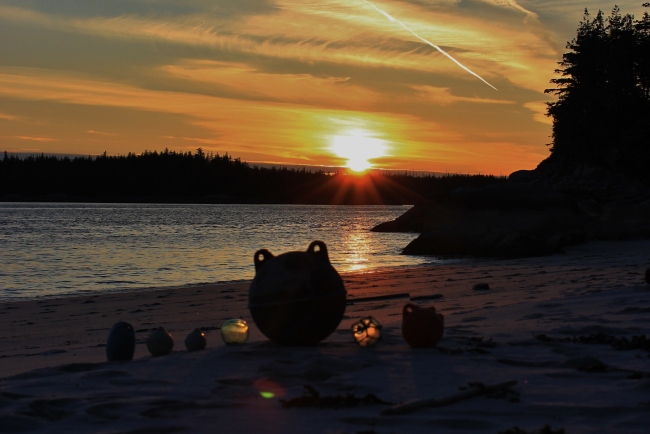
Day 7, July 8, 2013 – Pancakes. Delicious, delicious pancakes. Now, really pancakes are not that big of deal, however, when you have no utensils and a stove that only has one setting then pancakes are something to be proud of. We even had butter and maple syrup to complete the yummy meal. Today we finally saw our first whale! Jay seems to scare the whales off; I have never paddled this much and seen so few whales. It was a lone humpback that spent all day in the sound. We watched him for some time with him coming pretty close to us. We paddled north today which figures as the wind had changed direction and was now coming from the south so our paddle back was somewhat challenging. Not as many beaches on the northern stretch of Campania’s west side but there were some very unique rock formations and we did find one overturned aluminium boat washed up on shore. The wind calmed down tonight and we had a fire and dinner while watching the whale continue to feed. The coast guard and survey crew stopped by again tonight. Paul was the skipper, Craig was the main surveyor, and Josh was a surveyor in training. Based on the weather we decided to stay camped at our same place and figured Marc could find us tomorrow. We had been sending out two spot messages a day which included our coordinates so as long as he has been receiving those he will know where to find us! A week has gone by way too fast!

Day 8, July 9, 2013 – Back to civilization we go. We woke up early to pack up camp and wait for our ride. I wasn’t sure what time to expect Marc but I knew we may have to hurry getting things onto the boat once he got here so I wanted to be organized. It was yet another gorgeous day, last night was our first time this trip getting any rain. Even so, it was barely enough to get the ground wet. We had everything ready to go by 10am. We could hear boats coming from miles away and when we heard one we would call on the radio to see if it was Marc. I spent another hour and a bit doing one last thorough search for floats. Around 1 in the afternoon we saw and heard a boat. I called out on the radio “The Big O, The Big O, The Big O, Are you on this channel?” Marc replied and we continued to chat as I guided him around the rocks and to the beach. We loaded the gear into the hatches and put a kayak on each pontoon. Off we zoomed. Good-bye Campania! Good-bye Estevan! As the beaches got too far away to see I hoped to myself that the next time I see this place won’t be when it’s on the news with reports of an oil spill.










